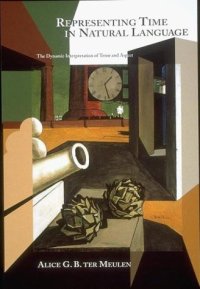
Ebook: Representing Time in Natural Language: The Dynamic Interpretation of Tense and Aspect
Author: Alice G. B. ter Meulen
- Year: 1995
- Publisher: The MIT Press
- Language: English
- djvu
Alice ter Meulen integrates current research in natural language semantics, with detailed analyses of English discourse, and logical tools from a variety of sources into an information theory that provides the foundation for computational systems to reason about change and the flow of time.
The topic of temporal meaning in texts has received considerable attention in recent years from scholars in linguistics, logical semantics, cognitive science, and artificial intelligence. Representing Time in Natural Language offers a systematic and detailed account of how we use temporal information contained in a text or in discourse to reason about the flow of time, inferring the order in which events happened when this is not explicitly stated. A new representational toolkit is designed to formalize an appropriately context-dependent notion of situated inference. Dynamic Aspect Trees representing temporal dependencies constitute a novel and important dynamic temporal logic that makes it easy to see what follows when from the information given in an ordinary English text.
Ter Meulen makes use of some of the fundamental assumptions of Situation Semantics and incorporates the dynamic methodology embodied in Discourse Representation Theory and in other dynamic logics into her temporal logic. The result is a computational inference system that can be applied across the board to fragments of natural languages.
The topic of temporal meaning in texts has received considerable attention in recent years from scholars in linguistics, logical semantics, cognitive science, and artificial intelligence. Representing Time in Natural Language offers a systematic and detailed account of how we use temporal information contained in a text or in discourse to reason about the flow of time, inferring the order in which events happened when this is not explicitly stated. A new representational toolkit is designed to formalize an appropriately context-dependent notion of situated inference. Dynamic Aspect Trees representing temporal dependencies constitute a novel and important dynamic temporal logic that makes it easy to see what follows when from the information given in an ordinary English text.
Ter Meulen makes use of some of the fundamental assumptions of Situation Semantics and incorporates the dynamic methodology embodied in Discourse Representation Theory and in other dynamic logics into her temporal logic. The result is a computational inference system that can be applied across the board to fragments of natural languages.
Download the book Representing Time in Natural Language: The Dynamic Interpretation of Tense and Aspect for free or read online
Continue reading on any device:

Last viewed books
Related books
{related-news}
Comments (0)